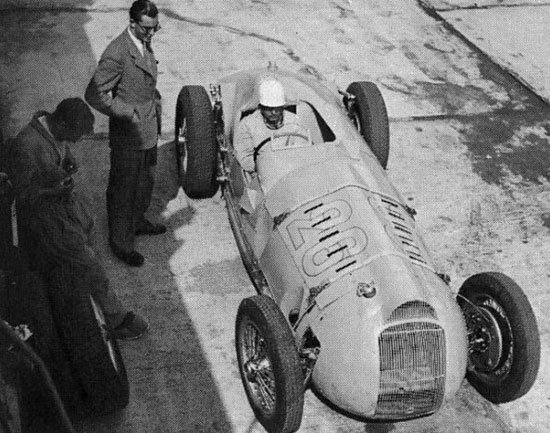8/2/1910 - 16/6/1994
Record updated 09-Feb-24
Comte George Raphaël Béthenod de Montbressieux raced under the nom de volant of 'Raph' he was a French-Argentine racing driver who sometimes entered races under his mother's of de las Casas.

Born in Buenos Aires, Raph was son of the Comte de Montbressieux, a rich silk merchant, and his wife, the daughter of the Argentine Minister of Justice (de las Casas).
He started racing in 1932 and, after three years of cyclecar racing with Amilcar, Salmson and Rally, he went into a partnership with Sommer to buy a Tipo B Alfa-Romeo for the 1935 season. They had apparently agreed to drive the car in alternate races. However it turned out that Sommer had bought the car outright and a second car had been built for Raph. Whether this was a misunderstanding by the factory or not, Raph ended up buying the other one for 150,000 French Francs.
He proceeded to race his Tipo B Alfa-Romeo successfully in 1935 before switching to to a Maserati V8RI (4504) for 1936, he was however very unhappy with the new car and after failing to finish in Barcelona and Genova, he took the car to the USA for the Vanderbilt Cup where he was disqualified for getting a push start. He sold the car and returned to Europe.
He raced Talbot and Delahaye sportscars in 1937 until Le Mans where he crashed badly. The accident happened at Maison Blanche when René Kippeurt lost control of his Bugatti Type 44 and was thrown from his car, his body was lying in the middle of the road. Fritz Roth was first on the scene and in trying to avoid Kippeurt and the wrecked Bugatti, he went off of the road and rolled. Pat Fairfield was next in his Frazer Nash and crashed into Kippeurt’s car, followed by Jean Trémoulet in a Delahaye 135CS and Raph in a Talbot T150C. The last car involved was Raoul Forestier's Riley Sprite TT. He jumped out and ran back up the track to warn the other drivers. Tragically Kippeurt was dead, Fairfield was severely injured and died two days later and Raph was seriously injured and was paralyzed from the waist down for six months.
Undeterred he was back in 1938 and raced Maserati voiturette with Piero Ettore Dusio's Scuderia Torino and Delahayes with Lucy O'Reilly Schell's Ecurie Bleue. He continued with Ecurie Bleue in 1939 with a best result of 5th in the German Grand Prix.

With Europe plunged into war, racing ceased and with France under German occupation, Raph was demobilised. He moved to Cannes in 1941 where he designed and built an electric vehicle called the Elecraph 225. In all about 40 Elecraph 225s were made.
After the war he travelled to America where he took part in a number of Midget races in California, even winning an indoor event in Los Angeles in 1946. He then returned to Europe and raced Maseratis under the Naphtra Course banner, backed by Madame Depois, finishing 3rd at Roussillon and Albi and winning at Nantes. He also finished second in the Grand Prix du Salon.
In 1947 he made the first of two trips to South America, finishing 3rd in the Grande Prêmio da Cidade de Rio de Janeiro at Gavea (see note 61 - Chap's tracks number 1, Gavea, The Devil's Trampoline) in a Maserati 4 CL and 6th at Mar del Plata. Back in Europe his season was beset with mechanical problems with the only highlight being he setting the fastest lap at the Grand Prix de l'ACF at Lyon.
He made his second trip to South America in 1948, this time with an Alfa Romeo 8C-308, finishing 2nd at both Interlagos and GP Cidade de São Paulo. Then, with additional backing, Naphtra Course became the Mundia Course and Raph bought one of the new Talbot-Lago 26C (110002), however after finishing 5th in the Grand Prix de l'ACT and a fine second in the Grand Prix du Comminges on August 8th, he crashed badly in the final of the Grand Prix de l'Albigeois at Albi three weeks later, suffering a fractured skull and partial amnesia.
He never fully recovered though he did race occasionally in 1949 and 1950 with a Delahaye 135, a Gordini and a Talbot mono-décalée. He sold the Talbot in Brasil when he made his final trip there in 1950 and retired from racing.
Financial problems set in and he went to work for his old friend Maurice Chevalier on the French Riviera as a handyman and chauffeur. When Chevalier died in 1972 he went to work for an company renting up market cars, finally retiring in 1984.
A lover of jazz music, he died almost completely forgotten in 1984 and is buried in the cemetery at Neuilly-sur-Marne, near Paris.
historicracing.com